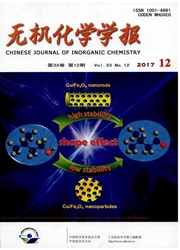

 中文摘要:
中文摘要:
本研究利用改进的溶胶-凝胶工艺合成了介孔硅基干凝胶。通过差热.热重(DTA—TG)、X-射线衍射(XRD)、红外光谱(FTIR)和N2等温吸附-脱附测试分析,以及扫描电镜(SEM)、透射电镜(TEM)观察,表征了硅基干凝胶的热效应、相态、结构、形貌特征,并对合成的硅基干凝胶进行了体外降解与细胞培养实验研究。测试结果表明:合成的硅基干凝胶为平均孔径3nm左右、最大比表面积901m^2·g^-1的介孔结构。体外模拟体液(Simulated body fluid,SBF)降解结果显示,低温处理的材料在42d内完全降解,直线拟合符合一级反应动力学方程。通过添加钙磷成分或高温煅烧处理可以调控干凝胶的降解速率,使硅基干凝胶的降解呈现直线式匀速降解的特征。体外细胞培养表明:硅基干凝胶可促进C2C12细胞(C3H小鼠肌原细胞)的分化和繁殖,证明材料的生物相容性良好。
 英文摘要:
英文摘要:
The mesoporous silica-based xerogel had been synthesized using improved sol-gel method. The thermal effect, crystalline state, structure and morphology characters of xerogel were measured by DTA-TG, XRD, FITR, SEM, TEM and N2 adsorption-desorption analysis. The degradation characterization and the cellular behavior were investigated by degradation test in simulated body fluid (SBF) and cultivation of cells, respectively. The results indicate that the synthesized xerogel was mesoporous material. The mean diameter of pores and the largest specific surface area of the xerogel were 3 nm and 901 m^2·g^-1, respectively. The low-temperature treated xerogel degraded entirely within 42 days, and degradation simulating curves was in accordance with one-order dynamics reactive equation. The xerogels degradation velocity was controlled at a relative low ratio, and degradation manner transformed into steady linearity character by sintering processes at high temperature, as well as adding calcium and phosphate ingredients into silica-based xeroel. The xerogel promoted the differentiation and conglomeration of C2Cl2 cells (C3H mice muscle cells), which revealed good biocompatibility of the material.
 同期刊论文项目
同期刊论文项目
 同项目期刊论文
同项目期刊论文
 Effects of The Composition of The Bioactive Composite Calcium Phosphate Cement on its Behavior in th
Effects of The Composition of The Bioactive Composite Calcium Phosphate Cement on its Behavior in th Development of a degradable cement of calcium phosphate and calcium sulfate composite for bone recon
Development of a degradable cement of calcium phosphate and calcium sulfate composite for bone recon Effect of Oxygen on Surface Properties and Drug Release Behavior of Plasma Polymer of n- Butyl Metha
Effect of Oxygen on Surface Properties and Drug Release Behavior of Plasma Polymer of n- Butyl Metha Development of mussel adhesive polypeptide mimics coating for in-situ inducing re-endothelialization
Development of mussel adhesive polypeptide mimics coating for in-situ inducing re-endothelialization Enhanced bioactivity of bone morphogenetic protein-2 with low dose of 2-N,6-O-sulfated chitosan in v
Enhanced bioactivity of bone morphogenetic protein-2 with low dose of 2-N,6-O-sulfated chitosan in v Long-circulating polymeric nanoparticles bearing a combinatorial coating of PEG and water-soluble ch
Long-circulating polymeric nanoparticles bearing a combinatorial coating of PEG and water-soluble ch Preparation and characterization of bioactive mesoporous wollastonite – Polycaprolactone composite s
Preparation and characterization of bioactive mesoporous wollastonite – Polycaprolactone composite s Radio Frequency Plasma Polymers of n- Butyl Methacrylate and Their Drug-Controlled Release Character
Radio Frequency Plasma Polymers of n- Butyl Methacrylate and Their Drug-Controlled Release Character Development of asymmetric gradational-changed porous chitosan membrane for guided periodontal tissue
Development of asymmetric gradational-changed porous chitosan membrane for guided periodontal tissue Self-setting Bioactive Calcium-Magnesium Phosphate Cement with High Strength and Degradability for B
Self-setting Bioactive Calcium-Magnesium Phosphate Cement with High Strength and Degradability for B 期刊信息
期刊信息
